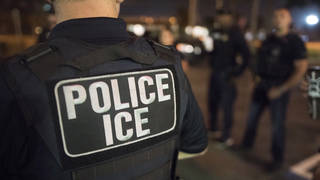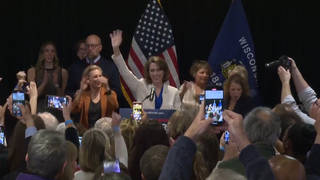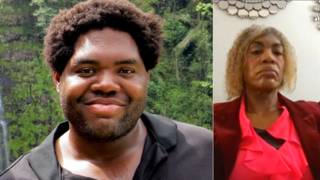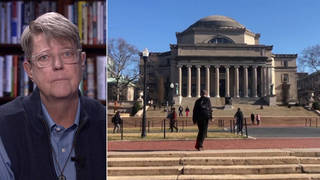
Amid grief and outrage over the killings of two unarmed African Americans in Chicago, a year-end report from the Mapping Police Violence research project says police nationwide killed at least 1,152 people in 2015. In 14 cities, every single police victim was African-American. And across the country, police killings had little correlation with crime rates and population size. We discuss the findings with Sam Sinyangwe, a statistician who worked on the Mapping Police Violence project.
Transcript
AMY GOODMAN: We turn now to San Francisco. A year-end report from the Mapping Police Violence research project says police killed at least 1,152 people in the United States in 2015. In 14 cities, every single police victim was African-American. Sam Sinyangwe is a policy analyst and data scientist with Campaign Zero and Mapping Police Violence.
Can you talk about these findings? Because there’s been a lot of demand for there even to be data collected in this country around police killings and the racial breakdown of those killings. How did you do this?
SAM SINYANGWE: So, as you mentioned, the federal government, including the FBI, Bureau of Justice Statistics and the CDC, do not collect comprehensive data on police killings nationwide. Fortunately, crowd-sourced efforts, such as KilledByPolice.net, FatalEncounters.org, have actually been able to collect the type of comprehensive data needed to do this type of analysis. What we did was merge those data sets, fill in the gaps, identify folks by race, whether they were armed or unarmed, and then make sense of all the data—understand which places were sort of hotspots of police violence and what some of the racial disparities in the data could tell us about how police violence impacts different communities.
AMY GOODMAN: So, talk about this number, both the over 1,115 people killed by police in the last year and also this issue of 14 cities, and explain which are these 14 cities, where the only people that police killed were African-American.
SAM SINYANGWE: Absolutely. So, what we found was that 1,190 people to date have been killed by police in the United States this year. That includes a number of folks, about a quarter of which were in America’s 60 largest cities. And so, as you mentioned, 14 of those cities, the police departments actually killed black folks exclusively. And so, some of these cities include places like Baltimore, St. Louis and other places where we’ve seen significant unrest over some of these practices that seem to target African-American communities. To give you a sense of what that means, nationwide, black folks are three times more likely to be killed by police and twice as likely to be unarmed when they’re killed by police. And so, clearly, these protests, what we’re seeing in Chicago and other places, is rooted in an experience of discriminatory policing that needs to end.
AMY GOODMAN: Explain how the FBI operates in terms of reporting police killings.
SAM SINYANGWE: So the FBI relies on a voluntary reporting mechanism. So, they basically depend on police departments to report accurate information on police killings. And as we’ve seen in entire states, and sometimes in individual jurisdictions, police departments have not stepped up and provided that data. And so, actually, the best data on police killings nationwide comes from local media reports. So when somebody is killed by police, usually—or, actually, almost all the time, it is mentioned in the media. And so, by culling those reports, aggregating them and then coding them by various characteristics of the incidents, we’re able to come up with these numbers.
AMY GOODMAN: What correlation is there, Sam, between high crime rates and high police killing rates?
SAM SINYANGWE: So, it’s an interesting question. What we’ve heard, particularly from the right, is—and from police folks—is that there is a connection between violent crime in communities and police violence, that—as they say, that communities with a lot crime have more police, and police get in more situations where they use force. However, what we found with the data is that that actually is not true, that there are communities with a lot of crime, places like Newark and Detroit, some of the most high crime cities in the country, that have comparatively fewer police killings than places that actually have much lower crime, places like Bakersfield. And so, actually, when you map this across, one of the things that we’ve done with the 60 largest cities at MappingPoliceViolence.org is we actually show the correlation, that in fact there is no correlation between the level of crime in a city, violent crime, and the rate of police killings in that city.
AMY GOODMAN: Can you talk about this last two killings of African Americans this weekend in Chicago?
SAM SINYANGWE: Yeah.
AMY GOODMAN: What does this say? How does this fit into the data you’ve found around Chicago?
SAM SINYANGWE: So, you know, the killing of Bettie Jones and Quintonio actually shows us that it’s part of a broader pattern and practice of discriminatory policing, policing that targets African Americans. So, for example, since 2013—so, 2013, '14 and ’15—Chicago police have killed 46 people. Seventy-two percent of those people have been black. Over 95 percent have been people of color. And so, when we look at the disparities in the data, it's clear that police in Chicago are applying a different standard to African Americans, in particular, than they are to other communities. And I think that is what is undergirding and is a context for a lot of the unrest that we see.
AMY GOODMAN: What are the cities with the highest rates of police killings, Sam?
SAM SINYANGWE: So, a couple of cities. One, Oklahoma City, consistently—this year, has been the second-highest rate of police killings; last year, it was number one. Bakersfield, California, is another city, St. Louis, another city, that have among the highest rates of police killings in the nation. To give you a sense for how high we’re talking, black men were actually killed by police at a rate higher than the U.S. murder rate in St. Louis last year. That is true for 17 of the 100 largest cities in America.
AMY GOODMAN: Based on the data that you have reviewed, what are you calling for?
SAM SINYANGWE: So, really, we’re calling for transformation in the way that policing operates in this country. We have launched a platform, Campaign Zero, at JoinCampaignZero.org, which articulates a 10-point plan for ending police violence in America. It includes things like empowered civilian oversight; ensuring that there is video evidence, so protecting the right of citizens to film the police and having body cameras; independent investigations and prosecutions; limits on the use of force, the policies that govern the use of force; as well as things like fair police union contracts, so making sure that police union contracts do not have provisions that, for example, delete officers’ records of past misconduct. So, in Chicago, for example, the police union contract actually mandates that officers’ disciplinary records be deleted and destroyed after five years. So there are many officers that actually may have a history of violence that we actually do not know about, because the union contract mandates that information be removed.
AMY GOODMAN: Sam Sinyangwe, I want to thank you for being with us, policy analyst and data scientist, member of the planning team of Campaign Zero and Mapping Police Violence, speaking to us from San Francisco.
This is Democracy Now! When we come back, we remember the filmmaker Haskell Wexler. Stay with us.












Media Options